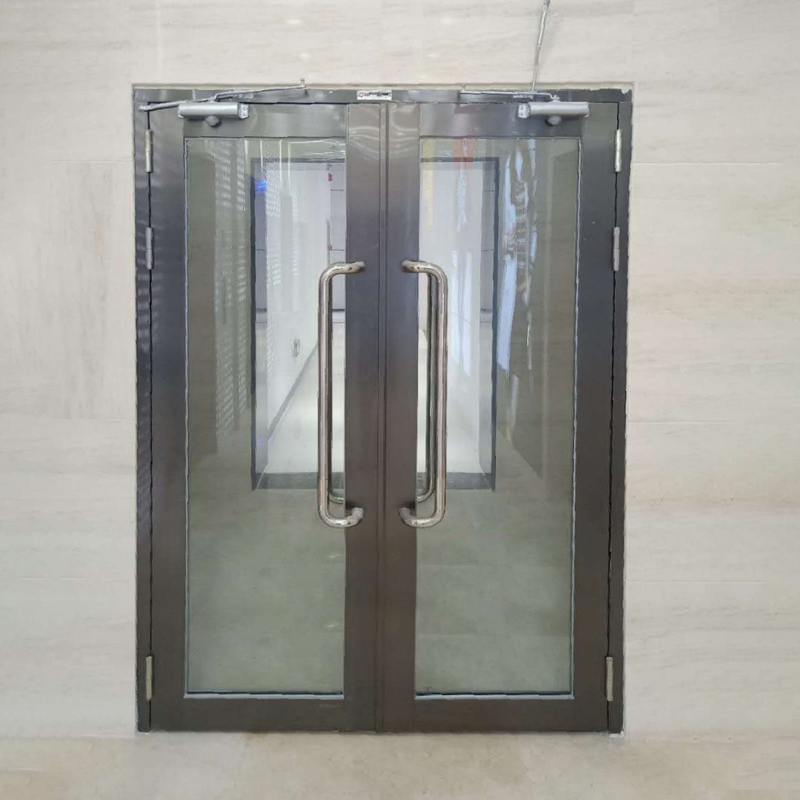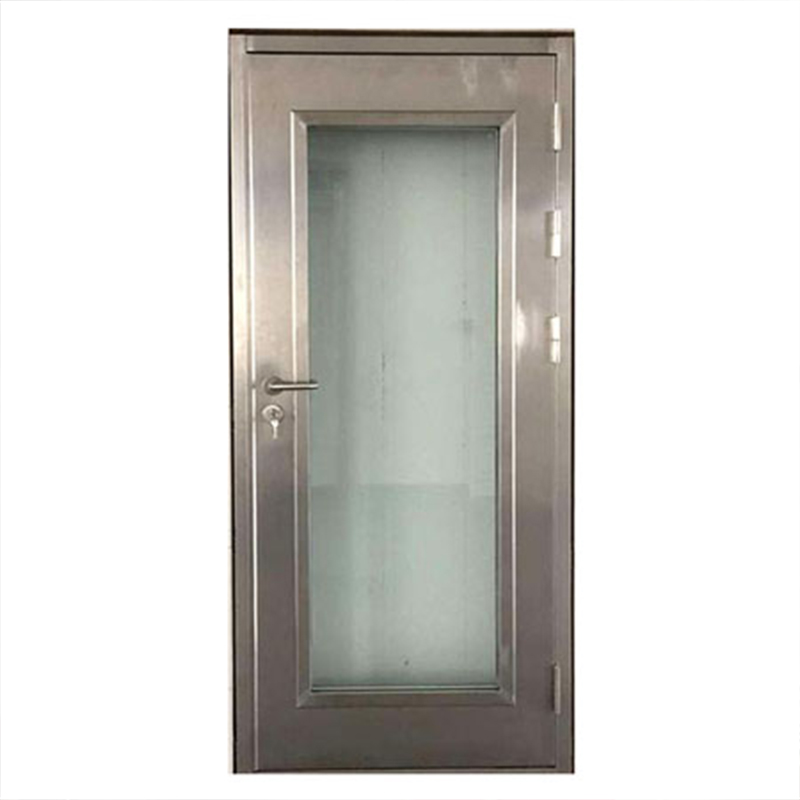In the field of building fire safety, glass fire doors, as an innovative product that combines fire resistance and aesthetics, are gradually becoming an indispensable part of modern buildings. It can not only effectively block the spread of flames and smoke when a fire occurs, buy precious time for personnel evacuation and fire fighting, but also meet the dual needs of buildings for lighting and decorative effects.
Types and characteristics of glass fire doors
Glass fire doors can be divided into many types according to their structure and function. Single-piece fireproof glass doors use a single layer of special fireproof glass, which is suitable for lower fire protection level requirements and has the characteristics of easy installation and strong ornamental properties. Composite fireproof glass doors are composed of multiple layers of fireproof glass and intermediate layer materials, have higher fire resistance, can effectively prevent the spread of fire smoke and smoke, and ensure that the affected people have enough time to evacuate the scene. Framed glass fire doors usually use metal frames (such as steel) to support the glass to improve the structural strength and fire resistance of the door.

In terms of characteristics, glass fire doors have many advantages. In terms of fire resistance, it uses special fireproof glass, usually multi-layer composite glass or laminated glass, which can maintain integrity for a certain period of time at high temperatures. Taking Class A fireproof glass doors as an example, Class C fireproof glass doors are mainly made of single-piece fireproof glass. The strength of this special glass exceeds that of float glass and is easy to install; Class A fireproof glass doors are made of composite fireproof glass, which has excellent heat insulation and sound insulation performance, and relatively high transparency. In terms of transparency, it provides good visibility, which helps escape and rescue during fire, and does not affect the lighting effect of the building. In terms of aesthetics, it is suitable for places that need to take into account both fire prevention and decorative effects, such as shopping malls, office buildings, hotels, etc. In terms of durability, its materials and design ensure the stability and reliability of the door in long-term use.
Fireproof grade and specifications of glass fireproof fireproof doors
Fireproof glass is the core component of glass fireproof fireproof doors, which can maintain its integrity in standard fire resistance tests. According to different fireproof performance, fireproof glass can be mainly divided into three common types. Class A fireproof glass has both fire-resistant integrity and fire-resistant heat insulation. It includes composite and infusion types. It is not only transparent, but also fireproof (smoke-proof, fire-proof, and heat-resistant), and has sound insulation and impact resistance. It is very suitable for steel-wood fireproof doors, windows, partition walls and other components in building decoration. Class B fireproof glass also meets the requirements of fire-resistant integrity and additionally meets the requirements of thermal radiation intensity. It is usually composite and has the characteristics of light transmission, fireproof and smoke-proof. Class C single-piece fireproof glass only needs to meet the standards of fire-resistant integrity. It has high transparency and has fireproof, smoke-proof and high-strength characteristics. It is suitable for fireproof glass partition walls, fireproof windows and other occasions that do not require special insulation.
Glass fire-resistant fireproof doors have various specifications, among which the commonly used ones are mainly divided into three levels: A, B and C, and the fireproof effect of Class A fireproof glass is the best. Class C fireproof glass doors are mainly made of single-piece fireproof glass, and their regular sizes range widely, with the largest size reaching 2400mm×5000mm and the smallest size being 200mm×300mm. Class A fireproof glass doors are made of composite fireproof glass, and their size range is relatively small, with the largest size being 1800mm×3000mm and the smallest size being 100mm×100mm. The size of fireproof glass doors is not fixed, and is usually tailored according to the size of the reserved door opening.

Installation and maintenance of glass fireproof doors
The installation of glass fireproof doors requires a professional installation team to ensure the close fit between the door frame and the glass to achieve the best fireproof effect. During the installation process, the door frame needs to be equipped with a sealing groove, in which a sealing strip made of non-combustible material should be embedded. Depending on the fire rating, glass fireproof doors should be installed with fireproof glass of the corresponding fire resistance limit. Aluminum silicate fiberboard should be used for proper padding around the glass. The melting temperature of locks, hinges, latches and other hardware components on fireproof glass doors must reach or exceed 950℃. At the same time, the hinges on the door leaf must not use bidirectional springs to ensure its fireproof performance. The door leaf and the door frame must be tightly filled with non-combustible filling materials. For Class A fireproof glass doors, the door panel thickness should reach 1.5mm, and the door panel should be made of 1.2mm thick steel plate. In addition, the reinforcement must also be made of 1.5mm thick steel plate with a spiral structure to ensure its stability. At the same time, the thickness of the steel plate must not be less than 3mm.
Daily maintenance is essential to ensure that glass fireproof fire doors can work properly in emergency situations. Regularly check the door frame, door leaf, door closer, hinge and other components to check for damage or wear. Use a clean and soft cloth to clean the surface of the door body and avoid using corrosive detergents. For metal parts, you can apply anti-rust oil appropriately to maintain its flexibility and extend its service life. Regularly test the function of the door closer to ensure that the door can automatically reset when closed. At the same time, check whether the door locks, latches and other accessories are operating smoothly. Check whether the sealing strips around the fire door are intact to ensure that it has good heat and sound insulation. Once any parts are found to be damaged or aged, they should be replaced immediately to ensure the overall performance of the fire door. For some complex problems, it is recommended to contact professional maintenance personnel for processing to avoid potential safety hazards caused by self-operation. After each maintenance, records should be kept, including the maintenance date, content, and problems found, etc., for easy tracking and management.

Application scenarios of glass fire doors
Glass fire doors are widely used in many industries. In commercial buildings, such as shopping malls, supermarkets, hotels, etc., these places usually have a large flow of people, and safe evacuation is crucial. Glass fire doors not only meet the aesthetic needs, but also provide necessary fire protection. In office buildings, modern office spaces often adopt open designs. Glass fire doors can maintain a wide field of vision while ensuring fire resistance. As a place with dense personnel and emergency evacuation, hospitals can ensure clear vision and facilitate evacuation when a fire occurs. High-end residential areas may choose to use glass fire doors to improve the overall beauty and safety of the building. Industrial facilities such as factories and warehouses, especially for those areas that need to maintain good visual contact during working hours, glass fire doors can also play an important role. Transportation facilities such as airports, railway stations, subway stations, etc., these public places have a large flow of people and high requirements for safe evacuation, and glass fire doors are indispensable safety facilities. In addition, special function rooms such as machine rooms, power distribution rooms, monitoring rooms and other important equipment storage places, as well as elevator vestibules, pipe wells, inspection ports and other places that require fire isolation are also suitable for installing glass fire doors.
Glass fire doors play an increasingly important role in modern buildings with their unique fire resistance, beauty and practicality. With the continuous development of construction technology and the improvement of people’s awareness of fire safety, the application prospects of glass fire doors will be broader. When choosing and using glass fire doors, we should fully understand their types, characteristics, fire ratings, specifications, installation and maintenance requirements to ensure that they can effectively protect the safety of people and property in the event of a fire. At the same time, we should also pay attention to the industry’s technological development and standard updates, continuously improve the performance and quality of glass fire doors, and provide more reliable protection for building fire safety.